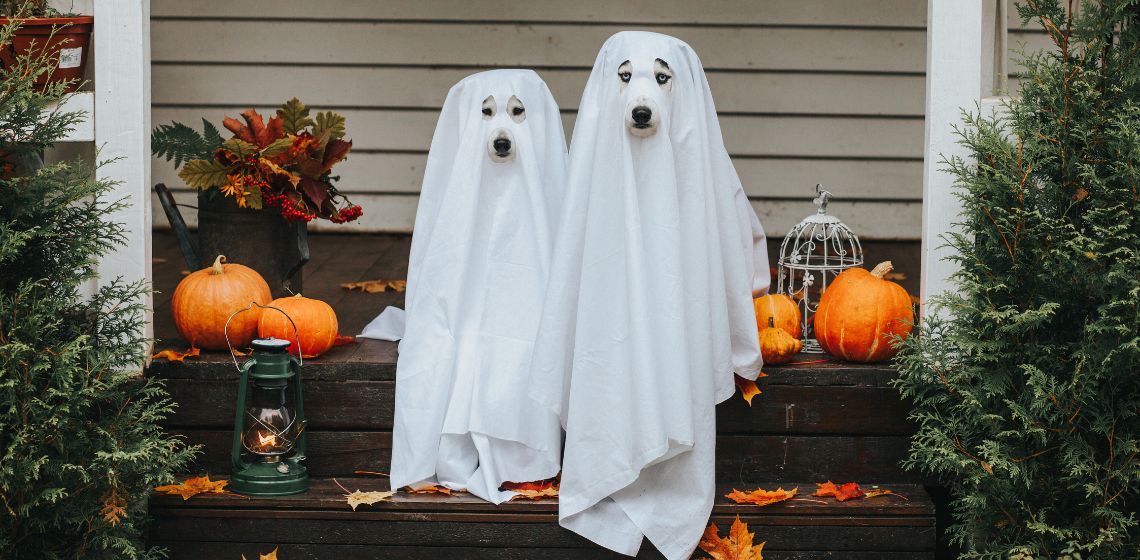Table of Contents
Scary Pet Toxins to Avoid This Halloween
Food and other substances can be toxic to pets. Certain poisonous agents are more common during certain seasons or holidays, like Halloween. If you are unsure whether a food or substance is poisonous for your pet, I recommend consulting Pet Poison Helpline.
Some common pet poisons to avoid during Halloween include:
- Chocolate: If ingested, chocolate can be extremely toxic and even deadly to dogs. Chocolate comes in many different forms including milk chocolate, Baker’s chocolate, cocoa powder, and more. Poisoning tends to be more severe when chocolate is dark and less sweet. The toxic components of chocolate are theobromine and caffeine, which can cause heart abnormalities, seizures, tremors, and hyperactivity.
- Candy and xylitol: Because of the potentially high sugar and fat content in candy, cats and dogs can develop pancreatitis (inflammation of the pancreas), especially if they consume candy in large amounts. Symptoms of pancreatitis may take a few days to manifest and include gastrointestinal signs (e.g. vomiting, diarrhea, decreased appetite), abdominal pain, and lethargy. Some candy is more toxic than others. For example, sugar-free candy often contains xylitol, which is highly toxic to dogs. This is because xylitol causes life-threatening hypoglycemia (low blood sugar) and liver failure.
- Grapes and raisins: Grapes and raisins are incredibly toxic to dogs and may also have detrimental effects on cats. Even if your pet only eats a small amount, grapes and raisins can cause severe kidney failure.
- Glow sticks and glow jewelry: Some pets like to chew on glow sticks and glow jewelry. Although less toxic than other substances, the dibutyl phthalate found in glow sticks can still elicit serious symptoms in pets. Symptoms include profuse drooling, skin and eye irritation, gagging, and vomiting.
If you suspect your pet has been exposed to any of the aforementioned pet toxins, contact your veterinarian immediately. As with any pet poisoning, time is crucial, and veterinary care should be sought right away.
While not toxic, candy wrappers are another relevant concern. This is because ingested candy wrappers can become a gastrointestinal foreign body, creating a blockage and often requiring surgical removal.
How to Decorate for Halloween When You Have Pets
Festive decorations are a great way to get into the Halloween spirit. But as a pet owner, how do you decorate safely?
Candles and lit jack-o-lanterns are fire hazards that can easily be toppled over by your pet. Your pet may also accidentally burn himself or singe his fur.
Fake cobwebs and string lights can be hazardous since pets can get caught or entangled in them. Also, be sure to stay away from any sharp decorations that could cause external injury to your pet. Other potential dangers include any decorations or parts of human costumes that could be swallowed and cause choking or a foreign body obstruction.
Decorating your home can seem like a big change from your pet’s perspective, which may induce stress. This is especially true in cats who are more sensitive to environmental change. Therefore, it may help to introduce Halloween decorations slowly in a stepwise manner rather than all at once.
Challenge yourself to get creative when it comes to making pet-friendly Halloween decorations. For example, The Humane Society of the United States recommends incorporating cardboard boxes and paper bags, which are particularly popular with cats.
Choosing a Pet-Friendly Costume for Your Furry Friend
Who can resist a pet in an adorable costume? But costumes are not appropriate for all pets. Depending on their temperament, some pets tolerate costumes and clothing more than others. Do not dress up your pet if it causes him anxiety or if he is prone to chewing on the costume.
The ASPCA cautions against costumes if they make your dog or cat stressed. Additionally, it is important that whatever costume you choose for your pet does not inhibit her ability to move, see, or breathe. Because of this, it is best to choose a costume that is simple or minimal.
Avoid costumes with loose components or accessories that could be swallowed. Furthermore, make sure your pet’s costume fits well and cannot get caught on anything.
You should also consider how long your pet will be wearing her costume. A more elaborate costume may be okay for a short period, such as for picture-taking whereas it may make your pet uncomfortable if you plan to dress your pet up all night.
If you plan to dress your pet up, it is helpful to acclimate him to the costume prior to Halloween.
Proper Identification to Prevent a Lost Pet
While Halloween may be exciting for us humans, remember that the holiday can be a chaotic and overwhelming experience for your pet. Because of this, some pets are more likely to run away and get lost on Halloween. Therefore, it is necessary for your pet to have proper identification in place prior to Halloween.
Identification should include a registered microchip, a well-fitted collar with ID tags, and recent pictures of you and your pet. These will come in handy if you and your pet become separated and need to be reunited. Be sure your contact information associated with the microchip and ID tags is current.
Before you decide to take your dog trick-or-treating with you and your family, be aware that the crowds of people in costumes may be stressful for your canine companion.
The best way to prevent your pet from running away and getting lost on Halloween is to keep them in a secure crate or room indoors. This is because your pet may perceive trick-or-treaters as a threat, especially if your pet gets triggered by their costumes. Keeping your pet in a secure area during holiday parties and trick-or-treating hours will help to reduce any agitation and stress.
Halloween is not without its risks but by following these tips, you can make Halloween a fun yet safe experience for you and your pets.

Dr. Amanda Takiguchi received her Doctor of Veterinary Medicine degree at Colorado State University. After that, she completed additional training at Texas A&M through a small animal rotating internship. Prior to veterinary school, Dr. Takiguchi studied dance and business management at Columbia University in New York City. She primarily works with dogs and cats but also loves exotic species like rabbits. Her favorite animal that has worked with is the native Hawaiian owl. When she is not promoting animal welfare, Dr. Takiguchi still loves to dance, with training in multiple styles including hip hop, ballet, and tap.








